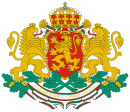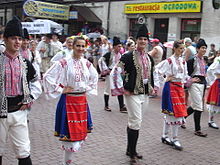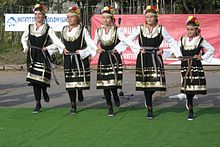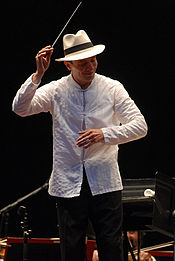- Music of Bulgaria
-
Part of a series on Bulgarians 
Culture of Bulgaria Literature · Music · Art
Cinema · Names · Cuisine
Dances · Costume · SportDiaspora United States · Canada
South America · Ukraine
Moldova · Spain
Italy · United Kingdom
Germany · France
Serbia · Romania
Hungary · Greek Macedonia
Albania · Turkey
People of Bulgarian descentReligions † Orthodox Christianity
(Bulgarian Orthodox Church)
small minority religions:
Muslim (by the Pomaks) · othersLanguages and dialects Bulgarian · Dialects The music of Bulgaria refers to all forms of music associated with Bulgaria like classical, folk, popular music, etc. Bulgarian music is part of the Balkan tradition, which stretches across Southeastern Europe, and has its own distinctive sound. Traditional Bulgarian music has had more international success, due to the breakout international success of Le Mystère des Voix Bulgares, a woman's choir that has topped world music charts across Europe and even farther abroad.[1]
Bulgarian vocals are said to be "open-throated", though this is somewhat of a misnomer. Singers actually focus their voices in a way that gives the sound a distinctive "edge", and makes the voice carry over long distances.
Contents
Instruments
Bulgarian music uses a wide range of instruments. Some folk instruments are variants of traditional Asian instruments such as the "Saz" (Bulgarian tambura), or the kemençe (Bulgarian gadulka). More modern style instruments are often used in the more modern dance music that was an offshoot of traditional village music.
Folk instruments
Bulgarian bands use instruments that commonly include:
- The gaida, a traditional goat-skin bagpipe. There are two common types of gaida. The Thracian gaida is tuned either in D or in A. The Rhodopi gaida, called the kaba gaida, is larger, has a much deeper sound and is tuned in F.
- The kaval, an end-blown flute that is very close to the Turkish kaval, as well as the Arabic "Ney."
- The gadulka, a bowed string instrument perhaps descended from the rebec, held vertically, with melody and sympathetic strings
- The tǔpan, a large drum worn over the shoulder by the player and hit with a beater ("kiyak") on one side and a thin stick ("osier") on the other
- The tambura, a long-necked metal-strung fretted lute used for rhythmic accompaniment as well as melodic solos. It is not dissimilar from the Greek buzouki.
- The tarabuka or dumbek, an hourglass-shaped finger-drum. It is very similar to the Turkish and North African "darbooka" and the Greek "touberleki" (τουμπερλέκι).
The new professional musicians of traditional Bulgarian instruments soon reached new heights of innovation, expanding the capacities of the gaida (Kostadin Varimezov and Nikola Atanasov), gadulka (Mihail Marinov, Atanas Vulchev) and kaval (Stoyan Chobanov, Nikola Ganchev, Stoyan Velichkov). Other, factory-made instruments had arrived in Bulgaria in the 19th century, including the accordion. Bulgarian accordion music was defined by Boris Karlov and later Gypsy musicians including Kosta Kolev and Ibro Lolov. In 1965, the Ministry of Culture founded the Koprivshtitsa National Music Festival, which has become an important event, held once every five years, showcasing Bulgarian music, singing and dance. The last festival was in August 2010.
Instruments used in Bulgarian wedding music
Instruments used in wedding music include violin, accordion, clarinet, saxophone, drum set, electric bass, electric guitar, synthesizer
Folk music
Regional styles abound in Bulgaria. Dobrudzha, Sofia, Rodopi, Macedonia, Thrace and the Danube shore all have distinctive sounds.
Folk music revolved around holidays like Christmas, New Year's Day, midsummer, and the Feast of St. Lazarus,[disambiguation needed
 ] as well as the Strandzha region's unusual Nestinarstvo rites, in which villagers fell into a trance and danced on hot coals as part of the joint feast of Sts Konstantin and Elena on May 21. Music was also a part of more personal celebrations such as weddings. Singing has always been a tradition for both men and women. Songs were often sung by women at work parties such as the sedenka (often attended by young men and women in search of partners to court), betrothal ceremonies, and just for fun. Women had an extensive repertoire of songs that they sang while working in the fields. Young women eligible for marriage played a particularly important role at the dancing in the village square (which not too long ago was the major form of "entertainment" in the village and was a very important social scene). The dancing — every Sunday and for three days on major holidays like Easter — began not with instrumental music, but with two groups of young women singing, one leading each end of the dance line. Later on, instrumental musicians might arrive and the singers would no longer be the dance leaders. A special form of song, the lament, was sung not only at funerals but also upon the departure of young men for military service.
] as well as the Strandzha region's unusual Nestinarstvo rites, in which villagers fell into a trance and danced on hot coals as part of the joint feast of Sts Konstantin and Elena on May 21. Music was also a part of more personal celebrations such as weddings. Singing has always been a tradition for both men and women. Songs were often sung by women at work parties such as the sedenka (often attended by young men and women in search of partners to court), betrothal ceremonies, and just for fun. Women had an extensive repertoire of songs that they sang while working in the fields. Young women eligible for marriage played a particularly important role at the dancing in the village square (which not too long ago was the major form of "entertainment" in the village and was a very important social scene). The dancing — every Sunday and for three days on major holidays like Easter — began not with instrumental music, but with two groups of young women singing, one leading each end of the dance line. Later on, instrumental musicians might arrive and the singers would no longer be the dance leaders. A special form of song, the lament, was sung not only at funerals but also upon the departure of young men for military service.The Bulgarian folk music is unique in Europe for its "asymmetrical" rhythms ( defined by the famous Hungarian composer and ethnomusicologist Bela Bartok as "Bulgarian rhythms" ), where the musical time is not split in even beats, but in longer and shorter.
The most important state-supported orchestra of this era was the Sofia-based State Ensemble for Folk Songs and Dances, led by Philip Koutev. Koutev has become perhaps the most influential musician of 20th century Bulgaria, and updated rural music with more accessible harmonies to great domestic acclaim. In 1951, Koutev founded the group known today as the Bulgarian State Television Female Vocal Choir, which became famous worldwide after the release of a series of recordings entitled Le Mystère des Voix Bulgares.
The distinctive sounds of women's choirs in Bulgarian folk music come partly from their unique rhythms, harmony and polyphony, such as the use of close intervals like the major second and the singing of a drone accompaniment underneath the melody, especially common in songs from the Shope region around the Bulgarian capital Sofia and the Pirin region. In addition to Koutev, who pioneered many of the harmonies, and composed several songs that were covered by other groups, (especially Tudora), various women's vocal groups gained popularity, including Trio Bulgarka, consisting of Yanka Roupkina, Eva Georgieva, and Stoyanka Boneva, some of whom were included in the "Mystery of the Bulgarian Voices" tours.
During the Communist era, some musicians lived outside the state-supported music scene. Without official support, wedding bands were also without official limitations on their music, leading to fusions with foreign styles and instruments. Thrace was an important center of this music, which was entirely underground until 1986, when a festival of this music, which became a biennial event, was inaugurated in the town of Stambolovo, and artists like Sever, Trakiîski Solisti, Shoumen and Juzhni Vetar became popular, especially clarinetist Ivo Papasov.
Folk dances
Main article: Bulgarian dancesOne of the most distinctive features of Balkan folk dance music is the complexity of its rhythms in comparison to Western music. Although it uses Western meters such as 2/4, 3/4, and 4/4, Balkan music also includes meters with 5, 7, 9, 11, 13, and 15 beats per measure, sometimes referred to as "asymmetric meters". These can often be understood as combinations of groups of "quick" and "slow" beats. For example, the dance lesnoto ("the light/easy one") has a meter of 7 beats with emphasis on the first, fourth, and sixth beats. This can be divided into three groups, a "slow" unit of 3 beats and two "quick" units of 2 beats, often written 3-2-2.
Each basic folk dance type use a distinct combination of these rhythmic "units". Some examples are rachenitsa (7 beats divided: 2-2-3), paidushko horo (5 beats: 2-3), eleno mome (7 beats: 2-2-1-2), kopanitsa (11 beats: 2-2-3-2-2), and Bucimis (15 beats: 2-2-2-2-3-2-2), and pravo horo, which can either be standard 4/4 or 6/8. Some rhythms with the same number of beats can be divided in different ways: for example, 8-beat rhythms can be divided 2-3-3, 3-2-3, 3-3-2, 2-2-2-2, 2-2-4, 2-4-2, 4-2-2, or even 4-4. This terminology is a crude simplification and is not used by Balkan musicians; it does not capture the full subtlety of the Balkan rhythms.
Selected discography of folk music
- Music of Bulgaria Original 1955 Recording (Nonesuch 9 72011) Early recordings of Philip Koutev and the Ensemble of the Bulgarian Republic. This was one of Frank Zappa's favorite albums, and Bulgarian harmonies reportedly influenced the harmonies of Crosby, Stills, Nash & Young. [2]
- Le Mystère des Voix Bulgares (Nonesuch 9 79165 in the U.S., 4AD Records CAD603CD in the UK) The Bulgarian State Radio and Television Female Choir, directed by Philip Koutev and Krasimir Kyurkchiyski. This is the world hit that introduced many to Bulgarian music. It is actually a collection of recordings by various artists and groups. A group that included some of these singers (and others) toured under this name.
- New Colors in Bulgarian Wedding Music, the Yuri Yunakov Ensemble (Traditional Crossroads 4283). Yunakov, a Bulgarian Roma saxophonist, is one of the creators, with clarinetist Ivo Papazov, of the modern Bulgarian "wedding music" movement. This album highlights his amalgamation of traditional Bulgarian music with more modern elements from rock and jazz.
- Village Music of Bulgaria (Elektra/Nonesuch 9 79195) Two albums of field recordings on one CD (A Harvest, a Shepherd, a Bride, and In the Shadow of the Mountain). One of the tracks, a recording of "Izlel je Delyo Hajdutin", was included by Carl Sagan and Ann Druyan on the Voyager Golden Record.
- Balkana The Music of Bulgaria (Hannibal HNCD 1335) Many of the songs are by Trio Bulgarka or one of its members.
- The Forest is Crying (Lament for Indje Voivoda) by The Trio Bulgarka (Hannibal HNCD 1342)
- Two Girls Started to Sing ... Bulgarian Village Singing (Rounder CD 1055) Field recordings
- Bulgarian Soul Bulgarian operatic mezzo Vesselina Kasarova sings Bulgarian folk songs with the Cosmic Voices from Bulgaria. Songs are arranged by the Bulgarian composer Krassimir Kyurkchiyski and accompanied by the Sofia Soloists Chamber Orchestra.
Orthodox
The tradition of church singing in Bulgaria is more than a thousand years old, and can be traced back to the early Middle Ages. One of the earliest known musical figure (composer, singer and musical reformer) of Medieval Europe Yoan Kukuzel (1280–1360), known as The Angel-voiced for his singing abilities, has Bulgarian origin. In the Bulgarian Orthodox Church there are two traditions of church singing - Eastern monodic (one-voice) singing and choral (Polyphonic). The Eastern monodic singing observes the tradition of Greek and Byzantine music, the requirements of the eight-tones canon of the Eastern Orthodox chanting. The second tradition is the choral church music, established during the 19th century, when in Bulgaria enters the influence of Russian choral church music. During XIX and 20th century many Bulgarian composers create their works in the spirit of Russian polyphony. Today Orthodox music is alive and is performed both during church worship services and at concerts by secular choirs and soloists. Contemporary Bulgarian worldwide recognized choirs and singers in whose repertoire permanently takes place the orthodox music are:
- St. Alexandar Nevsky Cathedral Choir
- "Madrigal" Chamber Choir
- Sofia Boys' Choir
- Sofia Orthodox Choir
- Sofia Priest Choir
- Yoan Kukuzel Choir
Classical
- Alexandra Fol
- Anatoli Krastev
- Anna Tomowa-Sintow
- Anna-Maria Ravnopolska-Dean
- Ari Leschnikoff - actual name Asparuh Leschnikoff
- Boris Christoff
- Dobri Hristov
- Dobrin Petkov
- Dobrinka Tabakova
- Emil Tabakov
Orchestras
- Emil Tchakarov
- Georgi Tutev
- Ghena Dimitrova
- Gheorghi Arnaoudov
- Hristo Tsanoff
- Konstantin Iliev
- Mariana Paunova
- Milen Nachev
- Nayden Todorov
- Neva Krysteva
- Nicola Ghiuzelev
- Nicolai Ghiaurov
- Pancho Vladigerov
- Raina Kabaivanska
- Ralitsa Tcholakova
- Rossen Milanov
- Svetla Protich
- Veneta Vicheva
- Vesselina Kasarova
Popular music
Pop
Some of the most popular artists include:
- Argirovi Brothers
- Bogdana Karadocheva
- Domino
- Doni
- Elitsa Todorova (Eurovision Song Contest 5th)
- Emil Dimitrov
- Galya
- Grafa
- Jony Iliev
- Karizma
- Lea Dimitrova
- Lili Ivanova
- Maria Ilieva
- Mariana Popova
- Mary Boys Band
- Mimi Ivanova
- Miro
- Neti
- Pasha Hristova
- Riton Duet
- Rushi Vidinliev
- Stoyan Yankulov (Eurovision Song Contest 5th)
- Svetla Ivanova
- Tonika
- Traichevi Duet
- Vasil Naidenov
- Yordanka Hristova
Chalga(Pop-folk) music
Main article: ChalgaChalga (Pop-folk) is a contemporary music style that combines sexually oriented Bulgarian lyrics with popular Eastern European and Arabic music. It is the Bulgarian version of the corresponding variations in neighboring countries such as Greece (Laika) and Serbia (Turbo folk).
Jazz
- Acoustic Version
- Anatoly Vapirov
- Hristo Yotzov
- Jivko Petrov
- Michail Yossifov
- Milcho Leviev
- Rossen Zahariev
- Rumen Toskov
- Simeon Shterev
- Simeon Venkov - Moni
- Theodosii Spassov
- Vasil Parmakov
- Veselin Veselinov - Eko
- Yildiz Ibrahimova
Electronic
- Deep Zone Project
- Esem
- Mira Aroyo (of Ladytron)
- Bulgaro
- Georg Hekt
- KiNK
- Res Corporales
- Star Tattooed
- trx
- Tkrst
- Gain Reduction
- Brain Disputer
- COOH
- Disco Nutter
- Balkansky
- Drum Kid
- Hyperqube
- Ogonek
Rap
Some of the most popular artists include:
Rock and metal
Some of the most popular artists include:
- Demenzia
- Diana Ekspres
- Distorment
- Epizod
- Face Up
- Faktor
- Frontpoint
- FSB(formatsia studio balkanton)
- Gabana
- Hipodil
- Holera
- Indignity
- Kale
- Klas
- The Revenge Project
- CREEP
- KPD-0
- Kontrol
- Kukeri
- Last Hope
- Marin Yonchev
- Monolith
- Never Again
- Neopit Pilski
- Not Broken In Spirit
- Nova Generacia
- Obraten Efekt
- Ostava
- Overdawn
- Pantommind
- the paperbax
- Pizza
- Poduene Blues Band
- Review
- Shturtzite
- Signal
- Skinflick
- Srebyrnite grivni
- Sunrize
- Tangra
- Voice of Glass
- Wickeda
- Zayo Bayo Gives Me The Creeps
Reggae
Some of the most popular artists include: Root Souljah - roots reggae pioneers in Bulgaria, Jahmmi Youth, NRG D, Ragga one, Samity - Dub Master.
World
- Bulgara
- Bulgarka Junior Quartet
- Georgi Yanev and Orpheus Orchestra
- Ikadem Orkestar
- Irfan
See also
References
- ^ Bulgarian is written using the Cyrillic alphabet, so transliterations into the Roman alphabet will result in minor variations of spelling (e.g., paidushko and padushka, gadulka and g'dulka).
- ^ Miles, Barry (2005). Zappa: A Biography. Grove/Atlantic, Inc.. p. 121. ISBN 978-0802142153.
- Burton, Kim. "The Mystery Voice". 2000. In Broughton, Simon and Ellingham, Mark with McConnachie, James and Duane, Orla (Ed.), World Music, Vol. 1: Africa, Europe and the Middle East, pp 36–45. Rough Guides Ltd, Penguin Books. ISBN 1-85828-636-0
- Vollan, Ståle Tvete. "Bulgarsk folkemusikk — musikktradisjon og feltarbeid". 1999. Trondheim, Norway. Master Thesis in Musicology + 1 CD, NTNU More info.
- Forsyth, Martha (1996). Listen, Daughter and Remember Well...: The Songs and Life of Línka Gékova Gérgova from the Village of Bístritsa. Sofia: St. Kliment Ohridski University Press. ISBN 954-07-0765-X. http://www.forsyths.addr.com/linka/.
External links
- (French) Audio clips: Traditional music of Bulgaria. Musée d'Ethnographie de Genève. Accessed November 25, 2010.
- Audio clip: Caval. The "Alexandre Dumas" School of Foreign Languages, Bulgaria. Accessed November 25, 2010.
- Audio clip: Gaïda. The "Alexandre Dumas" School of Foreign Languages, Bulgaria. Accessed November 25, 2010.
- Audio clip: Tupan. The "Alexandre Dumas" School of Foreign Languages, Bulgaria. Accessed November 25, 2010.
- Audio clip: Tarambuke. The "Alexandre Dumas" School of Foreign Languages, Bulgaria. Accessed November 25, 2010.
- Audio clip: Gadulka. The "Alexandre Dumas" School of Foreign Languages, Bulgaria. Accessed November 25, 2010.
- Audio clip: Tanbura. The "Alexandre Dumas" School of Foreign Languages, Bulgaria. Accessed November 25, 2010.
- Bulgarian music at the Open Directory Project
- - Bulgarian music collection with video clips (Bulgarian)
- - Lyrics, Biographies and Artist's albums (Bulgarian)
- Bulgarian folklore - Petar Ralchev & Jasen Atanasov Bassoon
Music of Southeastern Europe Albania · Armenia1 · Bosnia and Herzegovina · Bulgaria · Cyprus1 · Greece · Kosovo ·
Republic of Macedonia · Montenegro · Romania · Serbia · Thrace · Turkey1 · Yugoslavia1 Armenia, Cyprus and Turkey may be considered West Asian countries.
For further information, see Middle Eastern music.Music of Europe Sovereign
states- Albania
- Andorra
- Armenia
- Austria
- Azerbaijan
- Belarus
- Belgium
- Bosnia and Herzegovina
- Bulgaria
- Croatia
- Cyprus
- Czech Republic
- Denmark
- Estonia
- Finland
- France
- Georgia
- Germany
- Greece
- Hungary
- Iceland
- Ireland
- Italy
- Kazakhstan
- Latvia
- Liechtenstein
- Lithuania
- Luxembourg
- Macedonia
- Malta
- Moldova
- Monaco
- Montenegro
- Netherlands
- Norway
- Poland
- Portugal
- Romania
- Russia
- San Marino
- Serbia
- Slovakia
- Slovenia
- Spain
- Sweden
- Switzerland
- Turkey
- Ukraine
- United Kingdom
- (England
- Northern Ireland
- Scotland
- Wales)
- Vatican City
States with limited
recognition- Abkhazia
- Kosovo
- Nagorno-Karabakh
- Northern Cyprus
- South Ossetia
- Transnistria
Dependencies
and other territories- Åland
- Faroe Islands
- Gibraltar
- Guernsey
- Jan Mayen
- Jersey
- Isle of Man
- Svalbard
Other entities Categories:- Bulgarian people
- Bulgarian music
- Balkan music
Wikimedia Foundation. 2010.





